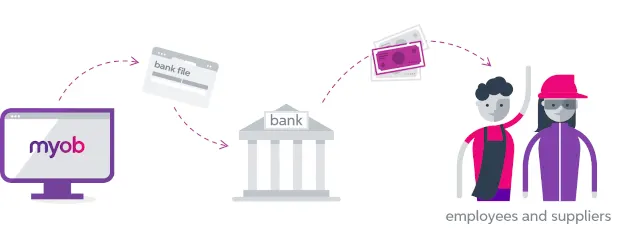After you record a payment to a supplier or employee in MYOB, you can then transfer the funds into their bank accounts using a bank file.
Why you should use electronic payments
More secure – no carrying wads of cash
Cash and cheque payments are becoming rare – your employees and suppliers are likely to expect cashless payments
Paying electronically from your MYOB software makes it easier to keep tabs on payments as it creates an audit trail
Using a bank file
You can pay employees and suppliers electronically using a bank file. Once you've completed some one-off setup tasks, you'll be able to create a bank file from MYOB then upload it to your bank for processing.

Setting up electronic payments
Before you can make electronic payments you'll need to set up a few things. Take a look at Setting up electronic payments for all the details.
Also find out how to split an employee's pay between multiple accounts.
Making payments
Once you're set up, you're ready to start making electronic payments. For all the details, see Making electronic payments.
FAQs
Do I have to pay my employees and suppliers electronically?
No, but there's good reasons to pay electronically, such as greater security and convenience and to keep an audit trail of payments in your MYOB.
When you're setting up your employees, you can decide which ones you want to pay electronically by choosing their payment method.
You can also decide which supplier payments you want to pay electronically when you enter their payment transaction by choosing the Electronic Clearing Account as the Bank account.
For more information, see:
Who in the MYOB business can use electronic payments?
Anyone who has access to the Banking, Payroll or Purchases areas of the MYOB business can set up and process electronic payments. Access to these areas is controlled by the roles and permissions that are assigned to each user in the MYOB business – see Users.